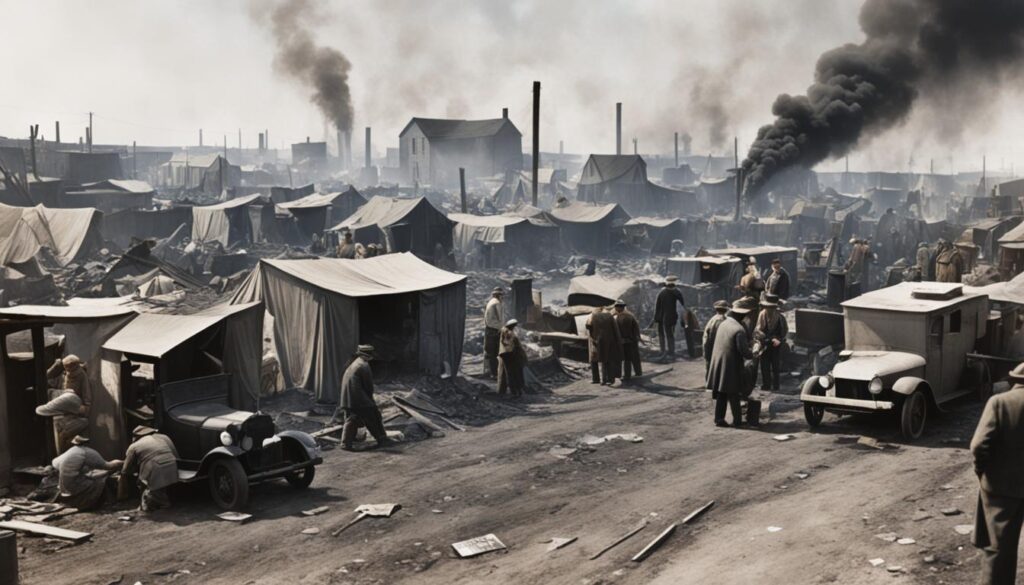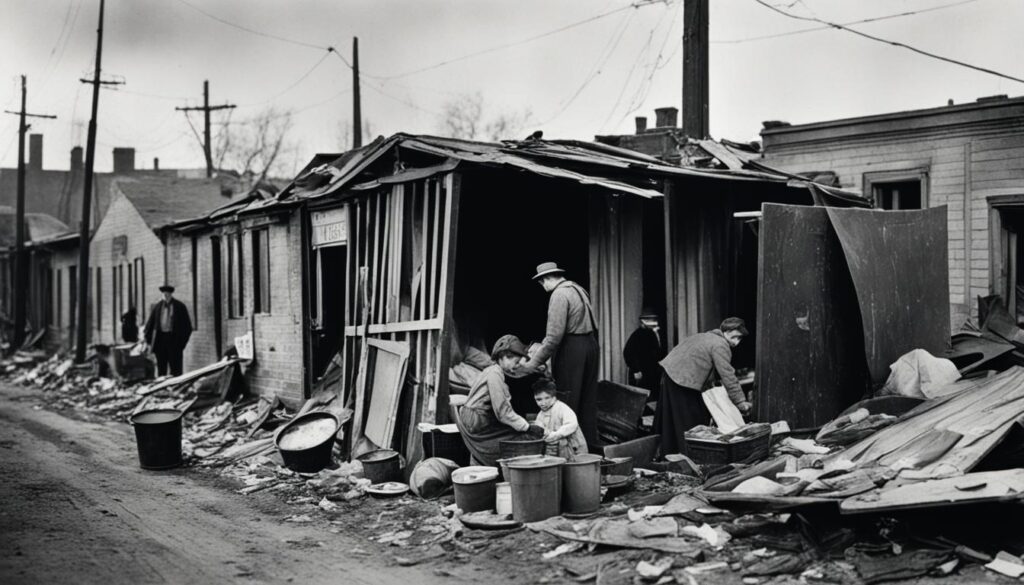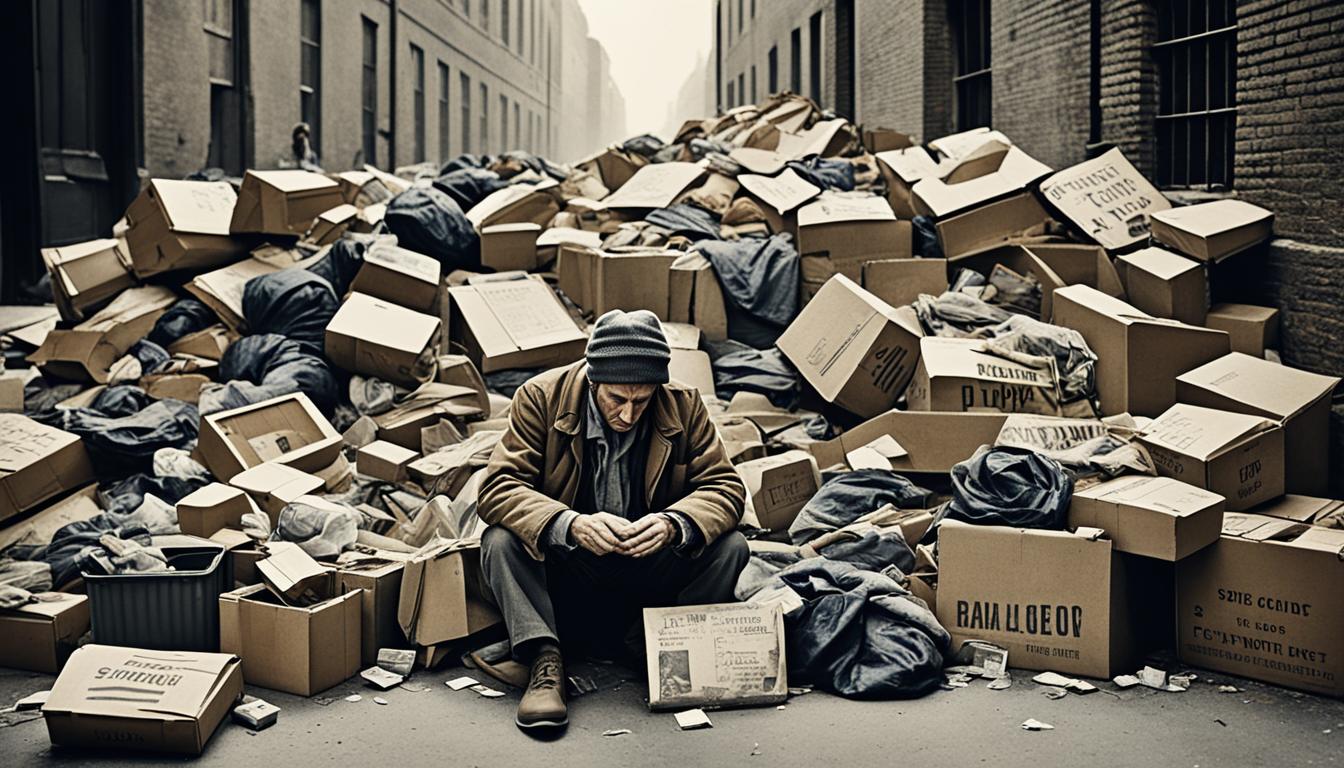“As an Amazon Associate I earn from qualifying purchases.”
Picture a time when everything seemed to fall apart, leaving millions in poverty and without homes during the Great Depression. This crisis from 1929 to 1939 was an unprecedented one. It darkened the Western world, causing huge drops in production, a lot of people losing jobs, and prices falling sharply.
Factories closed, taking jobs with them, and unemployment grew. At its worst, over 20% of people were without work. Due to a lack of support, many families ended up on the streets, turning the nation into a mix of shacks and hoovervilles.
This period made life hard for many as pay went down and standards of living dropped. People lost their savings and things they owned, making things even more difficult. Migrant workers, searching for work and escaping the Dust Bowl, also ended up in these poor settlements.
Key Takeaways
- Unemployment was a main sign of rising homelessness during the Great Depression.
- The U.S. saw a 47% drop in industrial output and 30% fall in real GDP, leading to job cuts.
- “Hoovervilles” started popping up, showing everyone how tough life was.
- With wages falling, savings disappearing, and living conditions getting worse, more people became poor and homeless.
- Those looking for work and running from the Dust Bowl added to the homeless numbers.
Unemployment: The Primary Catalyst
During the Great Depression, unemployment hit a new high. It showed how many people were losing their homes. Massive job losses led to millions living without regular pay.
Massive Job Losses
Factories shut down and companies reduced their sizes. This caused the jobless rate to go over 20%. Families struggled to buy food and find a place to live.
Lack of Social Safety Nets
No job meant no money during the Great Depression. Back then, there were no benefits or welfare to help. This lack of support pushed many onto the streets.
Migrant Workers and Drifters
Migrant workers and drifters traveled the country looking for work. They often ended up without a home. These workers lived in camps or travelled aimlessly, not finding work.
The Great Depression left an indelible mark on the nation, with unemployment serving as a grim harbinger of the homelessness crisis that would follow.
| Economic Indicator | Great Depression | Great Recession (2007-2009) |
|---|---|---|
| Industrial Production Decline | 47% | N/A |
| GDP Decline | 30% | 4.3% |
| Unemployment Rate | Over 20% | Slightly less than 10% |
The table shows how different the Great Depression was from the Great Recession. It points out the high unemployment and economic crisis that caused the 1930s homelessness issue.
The Rise of Shanty Towns and Hoovervilles
The Great Depression cast a shadow over America. It forced many into homelessness. With work hard to find and desperation growing, people started building shanty towns and Hoovervilles. These places offered a shaky roof for those impacted by the crisis.

Hoovervilles, mockingly named after President Hoover, showed the harsh living conditions all over. These settlements popped up quickly. They were made of leftovers like wood and tarps. This makeshift world showed how people can pull through hard times.
In 1935, it was estimated that between 4,000 and 5,000 homeless people were housed in Hoovervilles citywide during the Great Depression.
Seattle’s Hooverville stood as a home for about 1,200. It was a small part but showed the struggles of the whole country. This community had people from different backgrounds working together to make things better.
| Then | Now |
|---|---|
| During the Great Depression, Hoovervilles provided shelter for thousands of homeless individuals. | Today, suggestions include establishing geographically dispersed villages accommodating 100-150 people to effectively manage homelessness. |
| The Seattle Hooverville housed around 1,200 people in its shanties. | Research suggests the optimal size for human communities is around 150 people, indicating a potential model for modern Hoovervilles. |
| Hoovervilles were makeshift settlements constructed from scrap materials. | The new Hoovervilles are proposed to be more efficient and better planned, with micro houses, sanitation facilities, utilities, and modern technology. |
The first Hoovervilles were a last resort. But they still teach us valuable lessons. Around the world, people are using their story of courage and unity. They look for new ways to battle homelessness.
Poverty and Economic Crisis
The Great Depression hit the world hard, leading to widespread poverty and tough economic times. It caused a 47% fall in industrial production and a 30% drop in real GDP. As a result, wages went way down, and living standards got much worse.
Declining Wages and Living Standards
Factories closed and businesses failed, leaving many without a job. Even those who kept working faced lower wages. This made it hard for the middle class to maintain their usual lifestyle.
Loss of Savings and Assets
People also lost their savings and assets when banks collapsed and investments failed. The impact was huge, destroying many families’ financial safety nets. This made the poverty and economic crisis even worse, pushing more people into homelessness.
| Economic Indicator | Great Depression | Great Recession (2007-2009) |
|---|---|---|
| Decline in Industrial Production | 47% | – |
| Decline in Real GDP | 30% | 4.3% |
| Peak Unemployment Rate | Over 20% | Less than 10% |
The table clearly shows how severe the economic crisis was during the Great Depression. Comparing it to the Great Recession, we see the difference. The Great Depression’s impact was much deeper, with a 30% decrease in GDP and over 20% unemployment.
a main indicator of the spread of homelessness during the great depression was
The Great Depression was a huge economic disaster that hit the world from 1929 to 1939. The United States saw a massive economic downturn. This was because of severe unemployment and acute deflation. As a result, many Americans became destitute and lost their homes.

The numbers show a dark story. U.S. industrial production dropped by 47%. The country’s real GDP fell by 30%. The wholesale price index dropped by a third. Meanwhile, at the worst time, the unemployment rate went above 20%.
Nearly every industrialized nation felt the sting, with declines in wholesale prices of 30% or more between 1929 and 1933. The terms of trade for primary commodity producers also took a precipitous plunge.
Many people couldn’t find jobs or make money. So, they couldn’t afford a place to live. This made homelessness a serious issue. The problem got worse with falling prices and the value of what people owned decreased too. The hard times led to the rise of shanty towns and long lines for food, showing the depth of the crisis.
The Dust Bowl: Exacerbating Hardships
The Great Depression hit hard, but then came an environmental crisis called the Dust Bowl. This was a time when huge dust storms covered the Great Plains in the 1930s. The storms wiped out farms and destroyed the lives of many families.
Environmental Catastrophe
Poor farming methods and a long drought led to the Dust Bowl. Dust clouds soared up to 10,000 feet, turning day into night. These storms even reached cities like Chicago and Washington, D.C., hundreds of miles away.
Migration from Rural Areas
These storms ruined crops and blew away the soil. Many farmers lost everything, so they moved to cities looking for work. This migration from rural areas west, known from Steinbeck’s “The Grapes of Wrath,” included “Okies” and other migrants.
The Dust Bowl combined with the economic downswing of the Great Depression to create an environmental and humanitarian crisis unlike any other in American history.
This surge of new city residents strained the urban areas. They faced problems like not enough houses, few jobs, and unfair treatment. These issues made life even harder for families trying to escape the environmental catastrophe back home.
Bread Lines: A Visible Sign of Desperation
During the Great Depression, bread lines showed how bad things were. People waited in long queues for basic sustenance in every city. This was a telltale sign of the hard economic times. Many had lost their jobs and couldn’t feed themselves or their families.
With unemployment at almost 25%, soup kitchens and charitable efforts started helping. The Salvation Army and churches began providing warm meals. This act of kindness brought hope to those in dire need.
Long Queues for Basic Sustenance
In bread lines, people waited patiently for a meal, showing the crisis’s severity. These long queues went on for blocks. Families just wanted to find food to stop their hunger.
Soup Kitchens and Charitable Efforts
The government’s help was slow, but soup kitchens and charitable efforts moved quickly. Volunteers served soup, bread, and coffee to those who were hungry. They were a true lifeline.
| Year | Unemployment Rate | Families in Bread Lines |
|---|---|---|
| 1929 | 3.2% | 150,000 |
| 1933 | 24.9% | 3,500,000 |
| 1937 | 14.3% | 1,800,000 |
This table shows how unemployment and families in need increased during the Great Depression’s worst years. In 1933, at its worst, one in four people was without a job. This pushed 3.5 million families to rely on bread lines for meals.
Westward Migration: Seeking Opportunities
In the 1930s, the Great Depression hit many families hard. Jobs were scarce, and the future seemed dark. So, many families looked west for a chance at a better life. They were drawn to California by the hope of plentiful work and a brighter future.
The Lure of California
California’s riches were well-known even in the hardest-hit areas of the country. Its booming farms and factories made it seem like a promised land. People saw it as a place of endless opportunity, where a hardworking family could thrive. So, they set out, hoping for a new beginning.

Challenges Faced by Migrants
But the journey to California was not easy. Migrants faced many problems, from bad living conditions to racism. When they arrived, they discovered jobs were not as easy to get as they thought. They had to work very hard, often for little pay. For some, the dream of California turned sour.
Nearly one in four Americans who wanted a job could not find one at the lowest point of the Great Depression, while more than half of those employed had to settle for part-time work.
Still, people kept coming, showing incredible strength. They believed that California could be their saving grace. This hope powered them through the tough times of the Great Depression.
| Economic Indicator | Impact |
|---|---|
| Unemployment in the 1920s | Hovered around 7% |
| Bank Failures in 1930 | 1,352 banks failed due to bank runs |
| International Trade Decline | Dropped from $36 billion to $12 billion (1929-1932) |
| American Exports | Fell by 78% during the Great Depression |
| Smoot-Hawley Tariff | The highest tariff in U.S. history (1930) |
| J.D. Rockefeller’s Fortune | Four-fifths vanished due to the stock market crash |
The New Deal: Government Intervention
During the Great Depression, the U.S. faced a big economic challenge. President Franklin D. Roosevelt’s team came up with the New Deal. It was a series of new deal government intervention programs. They wanted to get the economy going again. Their goal was to reduce poverty and help those without homes.
Social Welfare Programs
The New Deal started many social welfare programs. These were to aid those hit hard by the depression. They gave food, shelter, and money to people in need. This support was like a safety net for those struggling.
Job Creation Initiatives
The New Deal also tackled the high unemployment rate. They started job creation initiatives. The Civilian Conservation Corps (CCC) was one such program. It hired over 2 million young men. They worked to protect forests and natural areas. This gave them a chance to earn and improve their lives.
The Agricultural Adjustment Act (AAA) of 1933 helped farmers. It gave them money for growing less food. This act boosted farm income by more than 50% between 1932 and 1935.
The New Deal marked a big change in how the government helped its people. It was all about keeping everyone safe and getting the economy moving again.
| Statistic | Value |
|---|---|
| Shares sold at the onset of the stock market crash (1929) | Approximately 13 million |
| Shares sold on Black Tuesday (October 29, 1929) | Over 16 million |
| People unemployed in the U.S. by 1932 | Around 15 million (approx. 25% of the labor force) |
| Decline in hourly wages during the Great Depression | Around 50% |
| Number of businesses that failed during the Great Depression | Exceeded 90,000 |
| Number of Americans who committed suicide in 1931 alone | Over 20,000 |
Conclusion
The 1930s Great Depression was a severe economic crisis in America. It led to widespread homelessness. This era is remembered for the rise of shanty towns or Hoovervilles.
Unemployment hit 25% in 1933, leaving millions without jobs or homes. These people built Hoovervilles from scrap materials and tents. This was a visible symbol of their struggle.
Beyond housing, the Depression affected daily life. Eateries were in long lines for food. Many found hope in moving west for better chances. The New Deal brought aid and jobs to help people.
FAQ
What was a main indicator of the spread of homelessness during the Great Depression?
How did unemployment contribute to the rise of homelessness?
What were “Hoovervilles,” and how were they related to homelessness?
How did poverty and the economic crisis contribute to homelessness during the Great Depression?
What role did the Dust Bowl play in exacerbating homelessness during the Great Depression?
What were bread lines, and how did they relate to homelessness during the Great Depression?
Why did many undertake westward migration during the Great Depression, and what challenges did they face?
How did the New Deal aim to address homelessness and economic conditions during the Great Depression?
“As an Amazon Associate I earn from qualifying purchases.”

